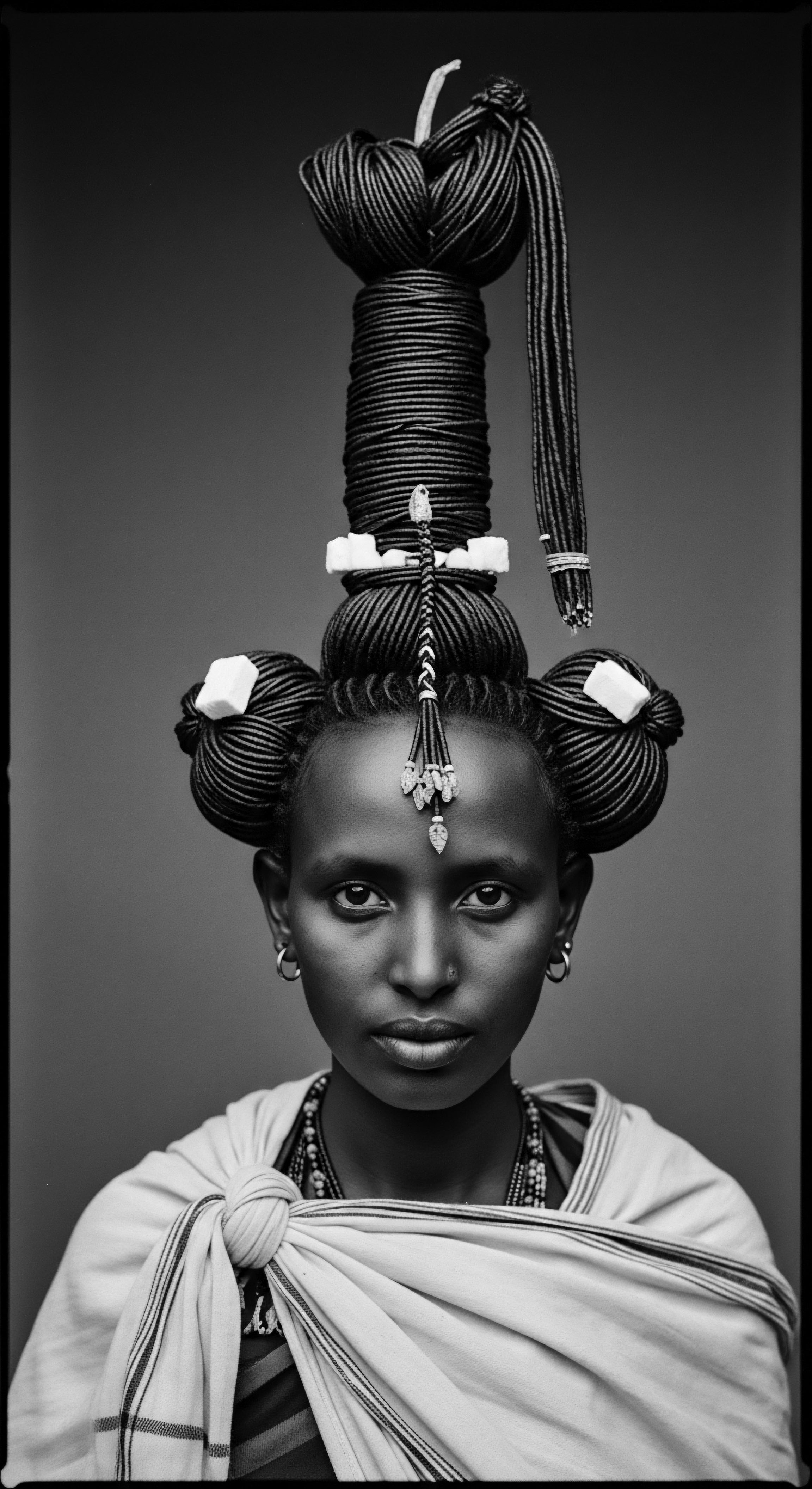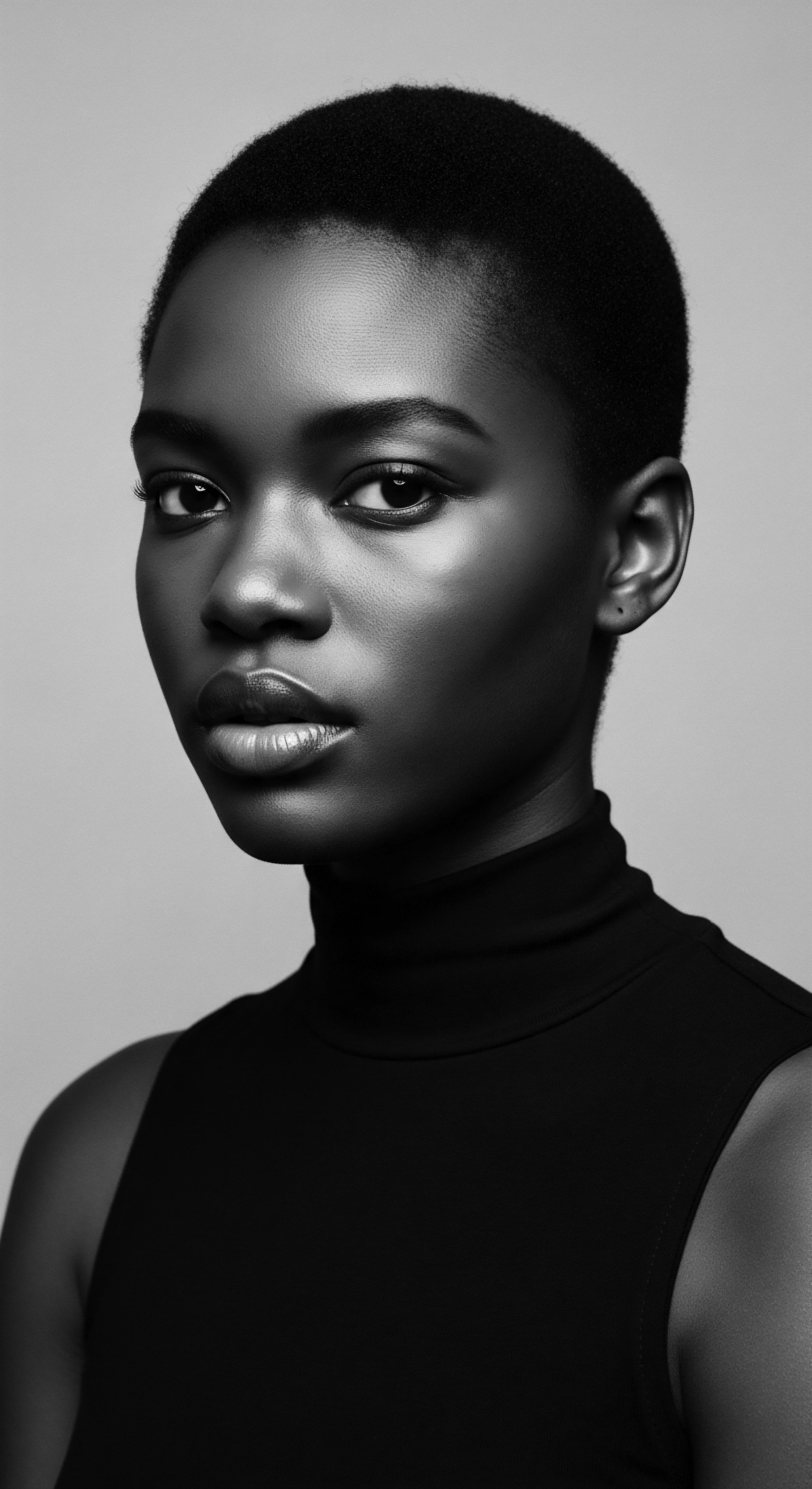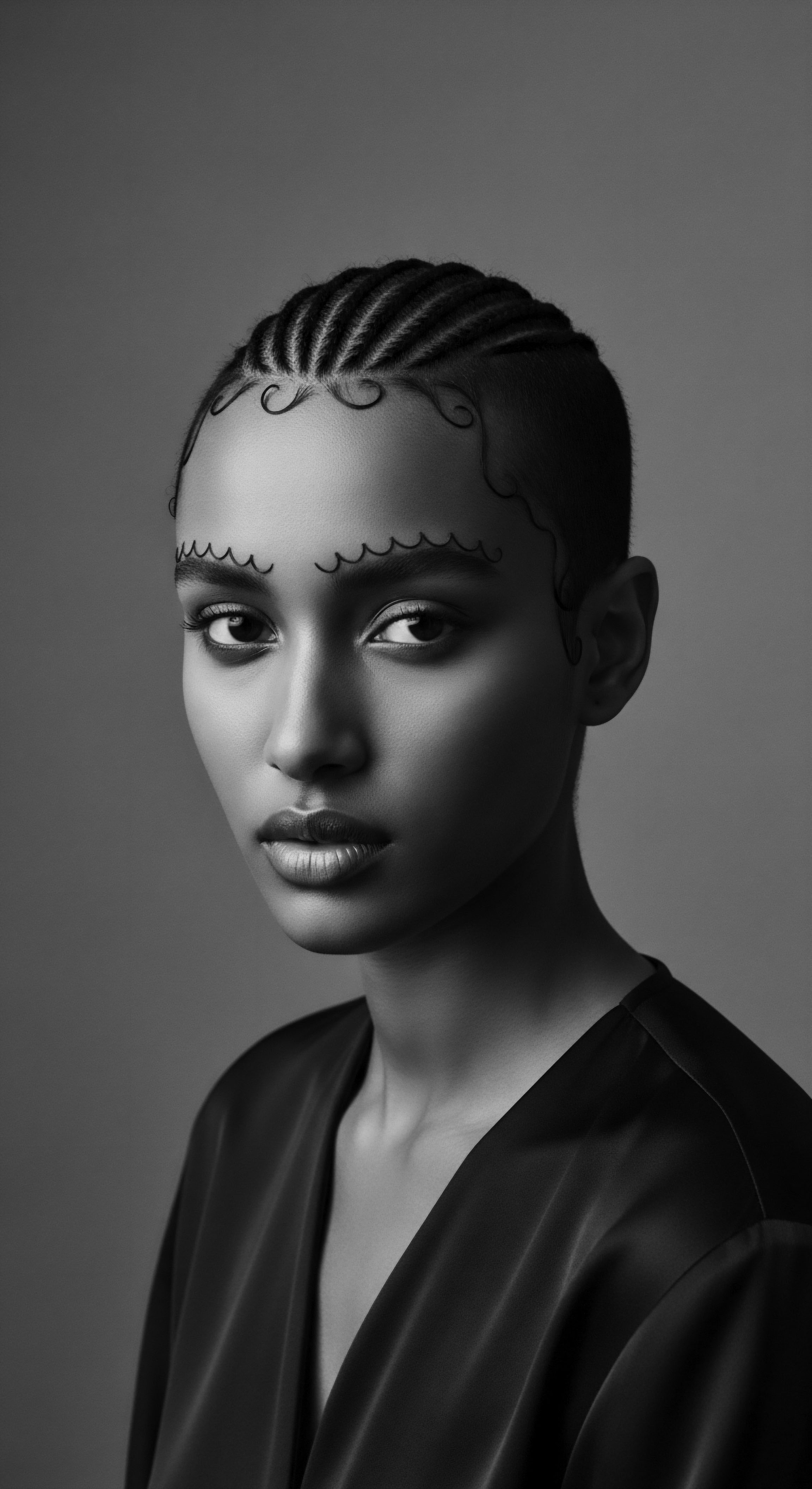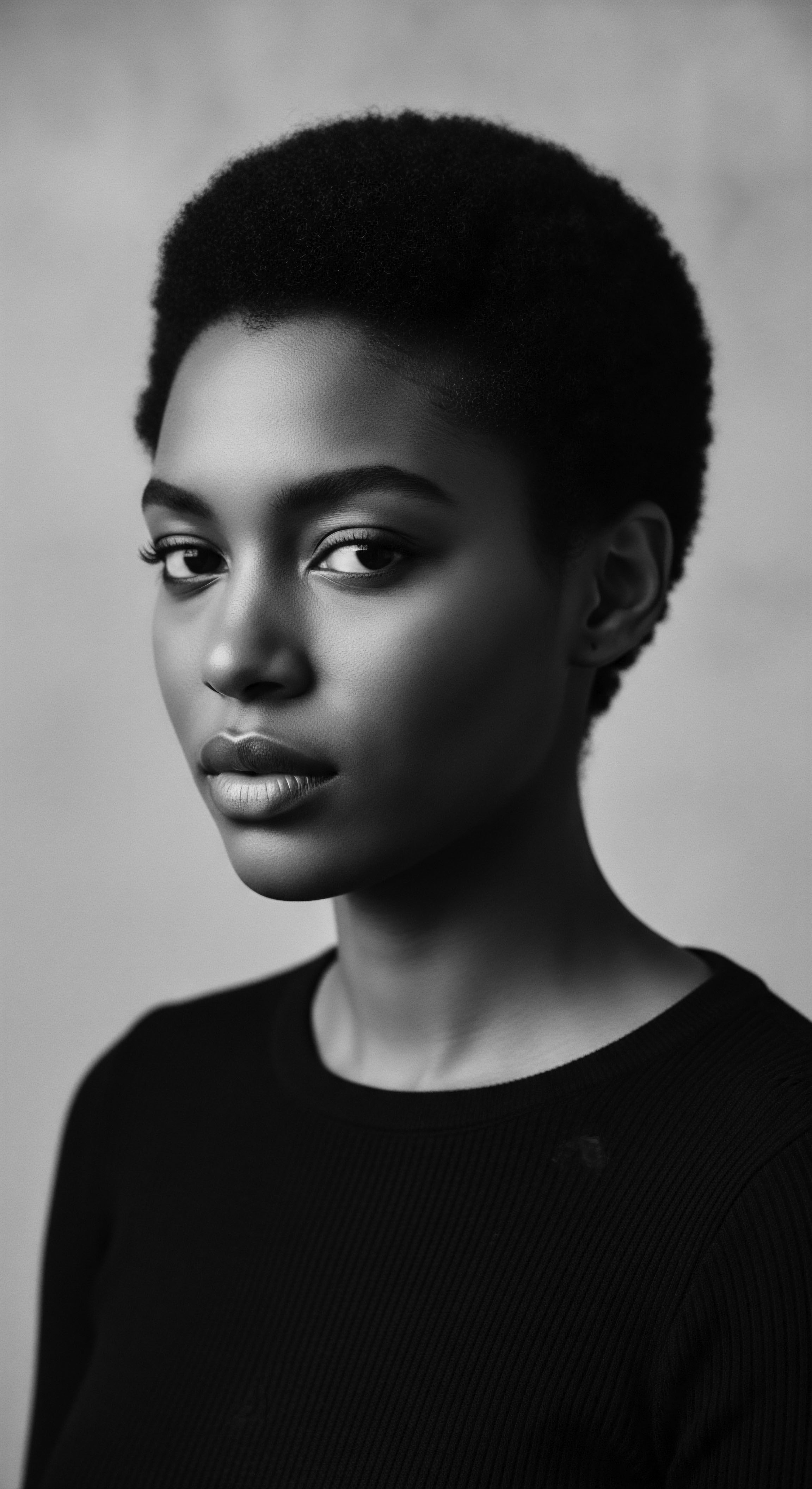
Roots
The very spirals, coils, and waves that crown our heads hold whispers of epochs, a vibrant lexicon etched not into parchment but into the genetic code of African peoples across the vast expanse of time. To gaze upon a textured strand, then, is to commune with a living archive, a testament to resilience and an intricate language spoken long before written alphabets dominated discourse. It is a story not merely of outward adornment, but of deep intrinsic connection, of belonging, and of identity woven into the very fibre of existence for ancestral African groups. The way hair behaved, its response to touch, its capacity for intricate shaping – these were not passive traits.
They were active participants in the silent, yet profoundly articulate, exchanges within communities, across generations, and indeed, between spiritual realms and the earthly plane. Our exploration of this profound heritage begins at the cellular level, in the quiet genesis of each curl.
Consider the architecture of textured hair. Its elliptical follicle shape and varied curl patterns – from the tightest coils to generous waves – determine how light plays upon its surface, how moisture is held, and how strands interact with one another. This biological blueprint is not uniform; it represents a stunning spectrum of forms, each a unique expression of ancestral lineage. This biological reality, a whisper from the very first cells, dictated the tools and techniques employed by early African societies.
For instance, the very curvature of the hair shaft itself, often flattened or oval in cross-section, contributes to its natural volume and strength, while also influencing its propensity for entanglement. The scientific understanding of the hair cuticle, composed of overlapping scales, helps explain why textured hair, with its often raised cuticles, was intuitively understood to require gentle handling and particular emollients to maintain its integrity against the harsh sun or arid winds.

Understanding Hair’s Ancestral Blueprint
From the dawn of human civilization in Africa, observation was the primary scientist. Ancestral African communities possessed an intuitive understanding of their hair’s unique properties, a comprehension gleaned from centuries of trial and collective wisdom. They recognized distinct hair types and, perhaps without formal nomenclature, developed practices attuned to these variations. A nuanced system of identification, passed down through oral tradition and lived experience, allowed for the development of highly specialized care.
Ancestral observation of textured hair’s intrinsic biological properties shaped the very first communication forms regarding its care and significance.
What were these distinctions? While modern classification systems like Andre Walker’s system (often cited for its broad strokes, though sometimes critiqued for its limitations) offer a contemporary framework, ancestral understanding was likely more localized and functional. It was based on how hair responded to water, how it felt to the touch, and its ability to hold a particular style. The inherent curl, often described as a series of Z-shaped or S-shaped spirals, determined the ease with which certain styles could be achieved or maintained, directly impacting their symbolic potency.

How Did Hair’s Physicality Inform Early Language?
The physical attributes of textured hair directly influenced the development of specialized vocabulary and non-verbal communication within early African societies. The very terms for different hair textures or states might have mirrored natural phenomena or familiar objects. For example, hair that was tightly coiled might have been described with words similar to those for a coiled snake or a spring, evoking a sense of powerful, contained energy.
Hair that was soft and flowing, perhaps like a river or wind, conveyed a different quality. This language was often embedded in proverbs, songs, and communal stories, becoming an inseparable part of cultural heritage.
- Coil ❉ Signified strength, resilience, and density, often associated with spiritual grounding.
- Braid ❉ Represented connection, lineage, and social structure within the community.
- Lock ❉ Carried connotations of enduring wisdom, spiritual commitment, and natural progression.
- Crown ❉ A universal symbol of royalty, dignity, and a connection to ancestral spirits.
The careful manipulation of hair, whether through braiding, twisting, or coiling, was a physical dialogue. Each twist and turn of the stylist’s hands, often accompanied by communal storytelling or song, imparted meaning far beyond mere aesthetic appeal. This was a direct, tactile form of communication, a heritage passed from elder to youth.

Ritual
The ritual of hair care and styling within ancestral African groups transcended simple grooming. It was a profound undertaking, steeped in reverence, communal exchange, and the transfer of ancestral knowledge. The hands that braided, twisted, or adorned hair were not merely shaping strands; they were sculpting meaning, weaving narratives into each pattern, and reinforcing social bonds.
This heritage of shared touch, focused attention, and intentional creativity formed a sophisticated communication network, silently conveying status, marital eligibility, clan affiliation, and even spiritual protection. The very act of styling became a tender thread connecting individuals to their lineage and their community, a living testament to shared cultural values.
Consider the intricate braiding traditions of the Fulani people of West Africa. Their distinctive braids, often adorned with cowrie shells and amber beads, extending along the sides of the head and sometimes hanging towards the cheeks, were not merely decorative. They communicated a woman’s marital status, her wealth, and her family’s social standing.
A young girl’s hair would be styled differently from a married woman’s, and the shift in these patterns marked life transitions, a silent announcement to the community. This is a powerful historical example of hair serving as a direct visual medium of communication, a testament to deeply ingrained heritage.

Styling as a Silent Language
Hair styling became a complex visual language, a shorthand for belonging and identity. Each twist, each knot, each section parted and shaped, held layers of meaning, understood by those within the cultural context. The tools used in these practices, often carved from wood or bone, were not just functional instruments; they were imbued with history, passed down through generations, their smooth surfaces telling tales of countless hours spent in communal care.

How Did Specific Styling Methods Convey Meaning?
Specific styling methods were akin to distinct dialects within this broader hair language. The direction of braids, the number of sections, the incorporation of specific adornments—all contributed to the message being conveyed.
For instance, among some ancestral groups, upward-swept styles might have indicated a readiness for war or a celebration, projecting a sense of alertness and dynamism. Conversely, downward-flowing styles could symbolize mourning, contemplation, or a state of peace. The patterns often mirrored natural forms, such as ripples in water or tracks of animals, grounding human expression in the natural world and reinforcing a connection to the environment. The process itself, often lengthy, necessitated sustained physical closeness and conversation, thereby fostering interpersonal communication alongside the visual one.
| Styling Technique Intricate Cornrows (e.g. Igbo, Yoruba) |
| Communicative Message & Heritage Often denoted social status, marital status, or tribal affiliation. Patterns could mimic village layouts or agricultural fields, reflecting communal organization and the land's bounty. |
| Styling Technique Braided Loops or Coils (e.g. Mangbetu) |
| Communicative Message & Heritage Could signify royalty, wisdom, or spiritual power. The distinct shapes were markers of prestige and lineage, connecting individuals to ancient traditions. |
| Styling Technique Dreadlocks or Matted Styles (e.g. Maasai) |
| Communicative Message & Heritage Represented spiritual devotion, rites of passage, or warrior status. The natural, unaltered state of the hair could be seen as a direct connection to primal forces and ancestral spirits. |
| Styling Technique Beads, Cowries, & Shells Adornment |
| Communicative Message & Heritage Communicated wealth, fertility, or protection from evil spirits. The specific materials and their arrangement held symbolic weight, passed down through generations. |
| Styling Technique These practices showcase hair as a powerful medium for non-verbal communication, deeply rooted in African heritage and cultural identity. |

Hair Tools and Ancestral Wisdom
The tools used in ancestral hair styling were extensions of the hands, carefully crafted implements reflecting an intimate knowledge of hair’s needs. Combs, often fashioned from wood or bone, were not simply for detangling; they were designed to work with the unique curl patterns, gently separating strands without causing breakage. These tools were often passed down through families, becoming tangible artifacts of familial heritage and a conduit for transmitting techniques.
Hair tools, crafted from natural elements, were not merely functional; they embodied ancestral ingenuity and facilitated the silent communication of hair artistry.
The selection of natural ingredients for oils, pomades, and treatments also speaks to a deep ancestral wisdom. Shea butter, palm oil, various plant extracts, and essential oils were chosen for their moisturizing, protective, and healing properties, intuitively understood long before modern chemical analysis. These ingredients, sourced from the local environment, connected hair care to the land and its resources, reinforcing a holistic view of well-being where human, spiritual, and environmental health were intertwined. This material heritage, along with the practices, solidified the role of hair as a central communication element in ancestral African societies.
The communal setting of hair styling, often under a shade tree or within a family compound, also deserves mention. It was a space for storytelling, for sharing gossip, for imparting moral lessons, and for strengthening kinship ties. The physical act of grooming became a catalyst for verbal and emotional exchange, proving that the silent language of hair was always complemented by the vibrant sounds of community. This heritage of shared time, shared space, and shared touch solidified the bond between individuals and reinforced their collective identity.

Relay
The communication encoded within textured hair transcended immediate social cues; it served as a robust system for transmitting knowledge, values, and historical narratives across generations and even between disparate ancestral African groups. Hair became a living chronicle, its styles mirroring the collective memory of a people, their migrations, triumphs, and struggles. This deep form of relay, often subconscious yet profoundly influential, established hair as a primary cultural archive, continuously updated and reinterpreted, yet always bearing the indelible marks of its heritage. The very act of maintaining and styling hair was a reaffirmation of continuity, a conscious decision to carry forward the wisdom of those who came before.
One particularly striking example of this communicative relay is the Kuba Kingdom of Central Africa, where the geometric patterns of hair braids and textile designs were intimately linked. These intricate patterns, often stylized representations of natural phenomena or significant events, were not only aesthetic but served as mnemonic devices, aiding in the recall and transmission of complex historical narratives and ethical principles. The replication of these patterns in hair was a tangible way to embody and circulate knowledge, ensuring that the collective heritage remained visible and accessible. This intertwining of hair artistry and codified wisdom represents a sophisticated system of information relay, deeply embedded in artistic expression.

Hair as a Cultural Repository
The intricate patterns crafted into textured hair were more than just adornments; they were often maps, timelines, and philosophical treatises. The very act of parting the hair, for instance, could signify a spiritual division between the self and the cosmos, or a boundary between different social roles. The meticulous creation of specific designs required not only skill but also an understanding of the stories and histories they represented, thereby ensuring their accurate transmission. This practice was a direct manifestation of ancestral wisdom, preserving cultural memory through visual means.

How Did Hairstyles Record Historical Events or Beliefs?
Certain hairstyles were historically documented to commemorate significant events, such as victories in battle, periods of famine, or spiritual awakenings. These “commemorative styles” acted as living memorials, allowing the wearer to carry their history on their head. For groups facing displacement or forced migration, hair patterns could even serve as clandestine maps, showing escape routes or pointing towards water sources, a silent, daring act of defiance and survival. These instances underscore the immense power of textured hair as a repository for collective experience and a means of coded communication in times of adversity, a heritage of ingenuity.
Furthermore, hair could communicate belief systems. The direction of braids, the use of certain knots, or the inclusion of specific sacred objects within the hair could signify religious affiliation, spiritual vows, or a connection to specific deities or ancestors. This religious communication was a profound demonstration of devotion and an affirmation of communal faith, solidifying the individual’s place within the spiritual tapestry of their group.
- Mnemonic Styles ❉ Hair patterns used to recall historical events, moral lessons, or traditional laws.
- Ritualistic Adornments ❉ Addition of specific charms, beads, or objects to hair for spiritual protection or blessing.
- Transitional Styles ❉ Hair altered to mark rites of passage, such as puberty, marriage, or elder status.

Connecting Past to Present Through Hair’s Narrative
The enduring heritage of textured hair as a communication tool continues to resonate in contemporary Black and mixed-race experiences. While the overt messages of ancestral styles may not be universally understood in modern contexts, the underlying principles of identity, connection, and self-expression remain powerfully present. The resurgence of natural hair movements globally is a testament to this enduring legacy, a deliberate reclaiming of ancestral forms as a declaration of identity and cultural pride.
The contemporary affirmation of natural hair styles represents a powerful echo of ancestral communication, reclaiming identity and cultural heritage.
The very act of wearing textured hair in its natural state, or in traditionally inspired styles, serves as a communicative act in societies that have historically sought to suppress or alter these forms. It is a statement of self-acceptance, a celebration of heritage, and a connection to a lineage of resistance and beauty. This modern ‘relay’ is not just about aesthetics; it is about reclaiming the power of self-definition that ancestral communities understood so intimately. The journey of textured hair, from ancient communal rites to contemporary global movements, reveals its unwavering position as a dynamic, living medium of communication, a testament to its enduring heritage.

Reflection
The journey through the intricate world of textured hair heritage reveals a profound truth ❉ hair was never merely a biological outgrowth for ancestral African groups. It was a living, breathing extension of identity, a canvas for communication, and a repository of collective wisdom. From the fundamental anatomy that dictated its care to the elaborate styling rituals that spoke volumes without a single uttered word, and the enduring relay of knowledge across generations, textured hair stood as a silent, yet undeniably eloquent, chronicler of human experience. The “Soul of a Strand” ethos, therefore, is not a poetic flourish; it is a recognition of this deep-seated vitality, an acknowledgement that within each curl and coil resides the echoes of ancestral whispers, the tender touch of communal care, and the unbound helix of a people’s enduring story.
Understanding this heritage is more than an academic exercise; it is an invitation to reconnect with a powerful lineage of self-expression and resilience. It beckons us to look beyond fleeting trends and perceive the profound, unbroken chain of wisdom that African communities forged through their relationship with their hair. The lessons from these ancestral forms of communication, rooted in visual cues and communal practices, offer a timeless reminder of how beauty, identity, and belonging are inextricably woven together. Our hair, indeed, continues to speak volumes, a living testament to a heritage that pulses with vibrant, untamed life.

References
- Opoku, Kwabena. (1997). The Significance of Hair in African Cultures. African World Press.
- Thiam, A. (2007). The Beautyful Ones Are Not Yet Born ❉ A Look at Hair and Its Significance. Mngadi Publishing.
- Byrd, A. D. & Tharps, L. D. (2014). Hair Story ❉ Untangling the Roots of Black Hair in America. St. Martin’s Griffin.
- Okeke-Ibezim, N. (2018). Black Hair in Africa ❉ An Intimate History. University of California Press.
- Akbar, N. (1998). The Psychology of the African American Hair Experience. Black Family Publication.
- Sieber, R. (1993). African Textiles and Decorative Arts. The Museum of Modern Art.
- Krieger, A. (2008). Hair in African Art and Culture. Rizzoli International Publications.
